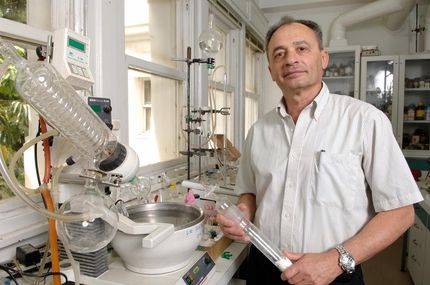Simultaneous analysis
Simultaneous carbon dioxide and oxygen sensing
Only plants can make sugars from the carbon dioxide byproduct and at the same time expel oxygen during photosynthesis. This amazing skill has intrigued scientists for decades but separating out the carbon dioxide inputs and outputs while keeping tabs on oxygen levels has always proved difficult.
Now, a new type of chemical sensor could change all that. The sensor developed by Otto Wolfbeis and colleagues at the Institute of Analytical Chemistry, Chemo- and Biosensors at the University of Regensburg, Germany, will allow clearer insights into plant respiration and photosynthesis. It could also have application in the food and drink industry as well as in the biotech industry where fermentation and related plant processes are important.
Woflbeis explains that in order to unravel the intricacies of photosynthesis and respiration, two of the most important biochemical processes, scientists have to be able to measure carbon dioxide and oxygen at the same time. He and his team have now found a way to side-step the interference from which all previous sensors suffer. The team first create nanoparticles carrying a fluorescent group that react to light and glow only when they are in contact with carbon dioxide molecules.
These nanoparticles are then embedded in a layer of polymer resin. A second compound that does the same in the presence of oxygen molecules is embedded in a second layer of polymer and the two films sandwich between them a layer of an organometallic compound containing the heavy metal iridium. This layer produces a reference signal for the detection of fluorescence triggered by the two gases. Importantly, however, it is impermeable to oxygen molecules and so its light is not quenched by interference from oxygen.
A blue light-emitting diode (LED) then provides the stimulation for the two sensitive layers to produce light, but only in the presence of their respective gases. A tiny photodetector can then measure the wavelength of light emitted, which is different from each sensor molecule. The strength of the emitted light at each wavelength correlates with the concentration of each of the two gases.
The team tested their sensor over a wide range of different carbon dioxide and oxygen concentrations produced by a growing microbial culture and found it to operate with a remarkable ±5% accuracy at concentration levels expected for real experiments. At much higher but unrealistic concentrations, accuracy deviated only by as much ±10%. Because the device is designed to be reusable rather than a one-shot dip test, the team tested its response after several hundred runs and found it to still be working at these levels of accuracy after 800 runs.
They anticipate that their composite material will become a powerful tool in biological, biotechnological, and medical research. The simultaneous sensor could also have applications in environmental monitoring of sea water and sewage and in medical diagnostics, where blood gas levels are important to understanding the progression of certain diseases. The research will be commercialized by Presens GmbH.
Original publication: O. Wolfbeis et al.; "Composite Material for Simultaneous and Contactless Luminescent Sensing and Imaging of Oxygen and Carbon Dioxide"; Advanced Materials 2006, 18, No. 12, 1511-1516.
Most read news
Topics
Organizations
These products might interest you

Octet R2 / Octet R4 / Octet R8 by Sartorius
Full power on 2, 4 or 8 channels: Label-free and GxP-compliant analysis of molecular interactions
Innovative label-free real-time protein quantification, binding kinetics and rapid screenings

Octet RH16 and RH96 by Sartorius
Efficient protein analysis for process optimisation and manufacturing control in high-throughput
Label-free protein quantification and characterization of protein-protein interactions

Octet SF3 by Sartorius
Surface Plasmon Resonance (SPR) using Single Dynamic Injections for Kinetics and Affinities
Curvature is Key - Adding a ‘Third Dimension’ to the Binding Curve

Get the analytics and lab tech industry in your inbox
By submitting this form you agree that LUMITOS AG will send you the newsletter(s) selected above by email. Your data will not be passed on to third parties. Your data will be stored and processed in accordance with our data protection regulations. LUMITOS may contact you by email for the purpose of advertising or market and opinion surveys. You can revoke your consent at any time without giving reasons to LUMITOS AG, Ernst-Augustin-Str. 2, 12489 Berlin, Germany or by e-mail at revoke@lumitos.com with effect for the future. In addition, each email contains a link to unsubscribe from the corresponding newsletter.
























































